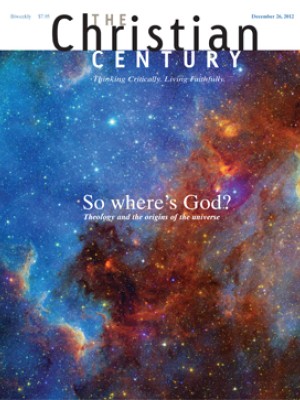Faith in 2-D

In the most recent season of HBO’s campy vampire drama True Blood, the writers and directors took on religion. They introduced a fundamentalist vampire sect that adheres to a scripture older than the Bible, believes that God is a vampire and that God’s first creation was the vampire Lilith. Through subterfuge and violence this sect has positioned itself at the head of the Vampire Authority, the worldwide vampire governing body that operates in shadowy allegiances with human governments.
For this sect, humans are no more than cattle, created by God for the sustenance of the real bearers of the imago Dei, vampires. With fanatical glee, these “sanguinistas” cast off their mainstream guises and massacre humans for food and pleasure. The season follows two of the show’s vampire figures—Bill Compton and Eric Northman—as they are wooed by and eventually join the religious extremist vampires. That both are former lovers of the main human character, Sookie Stackhouse, raises the stakes (all puns intended) of their conversion: will the practices of their newfound religion apply even to Sookie? Is she too no more than a tasty meal?
Read our latest issue or browse back issues.
Surely a show with the budget and writing talent of True Blood could come up with some interesting ways to explore the perennial question about the relation of reason and emotion in the formation of faith. Can zealous belief align itself with humility and respect for other beliefs? By what measure do we judge our own and others’ religions?
Instead of exploring such questions, the show offers only blood orgies and platitudes about religious fanaticism. Apparently religious belief of any kind leads to a mindless obedience and the destruction of the human race.
There must be something in the water, because a few months earlier Showtime’s rival bloodfest drama Dexter also took up religion. In this case too, religion largely meant violent religious fanaticism in the form of Doomsday Killers who stage apocalyptic living tableaux in an effort to bring about the end of the world.
Dexter Morgan, the main character, is himself a serial killer who channels his murderous impulses toward killing other serial killers. The series shows him exploring facets of human life—family, sex, politics—and questioning whether he can participate in them despite his severe emotional and psychological handicaps. At the same time he reveals how often these normal institutions can appear pathological from the outside.
Again, the drama offers fertile ground for exploring fascinating questions: Can religious belief “cure” pathologies? How do religious communities care for and uphold weaker members? What is the relationship between belief, community and morality?
As it turns out, the Doomsday Killers are one schizophrenic killer with an apocalyptic faith. All other models of religious belief are either dismissed as trivial (“I don’t know, Dexter, it just makes me feel good to believe in something greater than myself”) or killed off.
It may seem naive to complain that television doesn’t get religion. After all, you might say, television is just entertainment with a heavy side of advertising. But this is the new golden era of TV, and many shows explore moral and psychological issues with the seriousness of a 19th-century novel. Why not treat religion with the same seriousness?
Other acclaimed shows have displayed a similar reluctance to explore religion. Mad Men has included only one religious figure, a Vatican II priest whose proclivities for the guitar are meant to stand in for the religious turmoil of the 1960s. Only a few snide remarks about religion versus science appear in Breaking Bad. Even The Wire, for all its brilliance in portraying urban life, did not consider religious institutions as significant as government, economics, education or journalism.
The absence of religion in an otherwise rich era of television drama might suggest that religion hasn’t been a major force in public or private life—but that claim won’t stand much scrutiny. Maybe the scriptwriters who have proved to be deft at dissecting every other human motivation under the sun just don’t know how to convey the inner lives of religious believers. Resorting to clichés about fundamentalism, violence, terrorism and fanaticism must be easier than exploring what a good Christian girl like Sookie Stackhouse thinks about vampires, or showing what Dexter thinks about encountering the everyday practices of a loving congregation.
If television can chronicle the lives of mobsters, advertising executives, meth dealers and serial killers, it is not too much to ask for a believable religious believer now and again.






